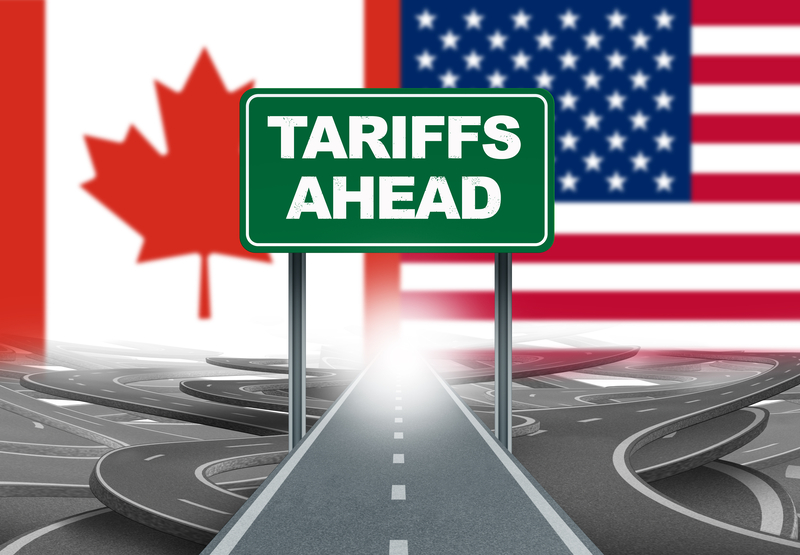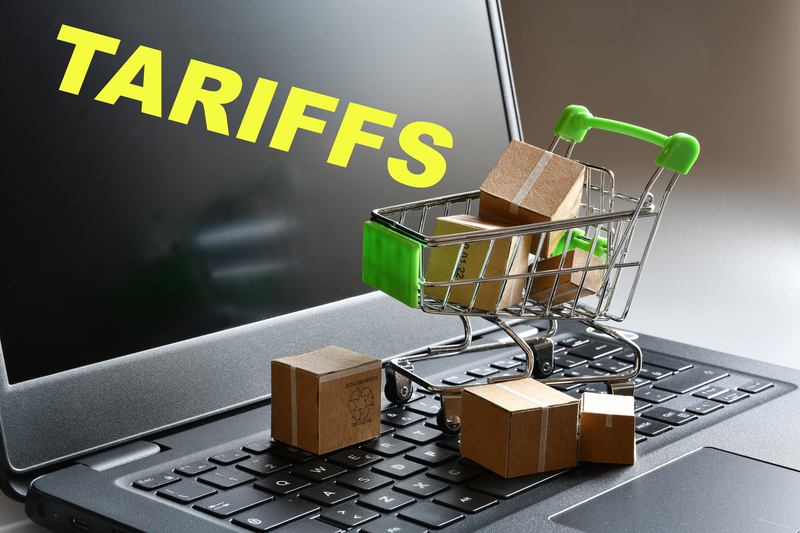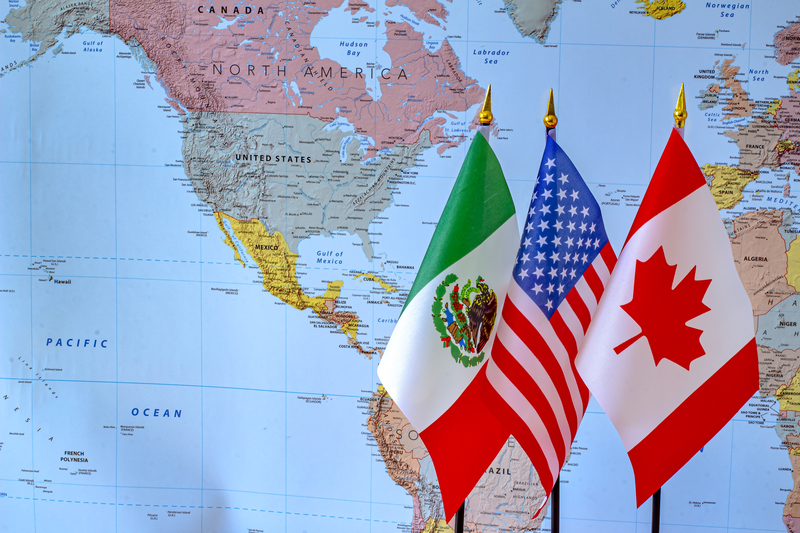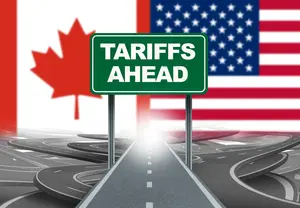How Tariffs Impact Canadian Small Business
An Introductory Primer for Uncertain Times
By L.Kenway BComm CPB Retired
This is the year you get all your ducks in a row! Start by starting.
Published August 22, 2025 | Edited September 8, 2025 | Updated November 28, 2025
WHAT'S IN THIS ARTICLE
Breaking News | Why You Need to Understand Tariffs Now | Tariff Basics | How This Hits Your Bottom Line | Hidden Ripple Effects | Your Early Warning System | Practical Strategies That Work | Government Relief Available | Your Action Plan | Bottom Line
NEXT IN SERIES >> Duty Free Shipping Is Over
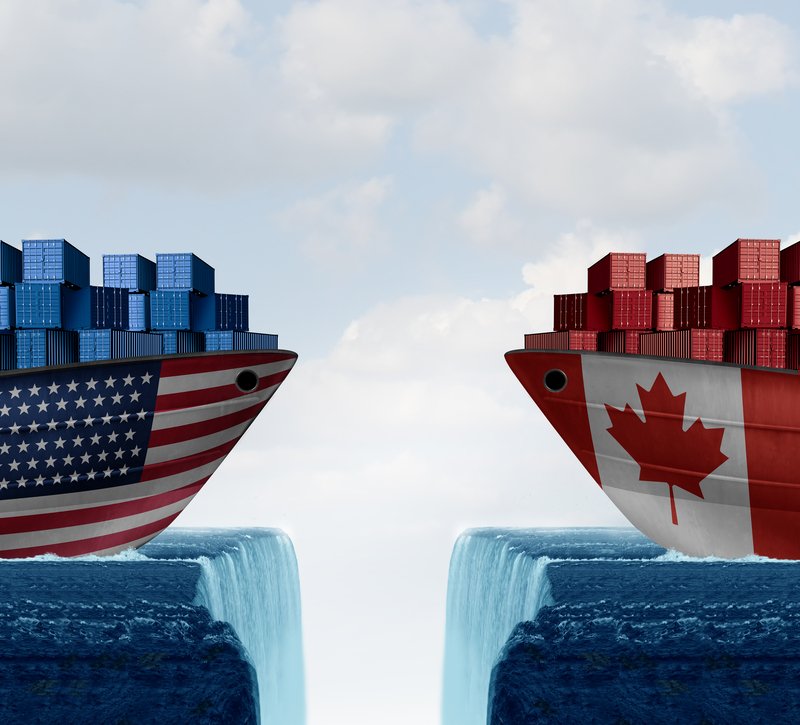 Understanding how tariff trade tensions affect your Canadian small business operations
Understanding how tariff trade tensions affect your Canadian small business operationsOctober 24, 2025
BREAKING: Canada's Trade Strategy Takes Shape
Prime Minister Carney spoke to University of Ottawa students on Wednesday, October 22, 2025. CBC News reported that during his pre-budget speech, he told students to prepare for "challenges" and "sacrifices" and said transforming Canada's economy won't happen "easily or in a few months".
He acknowledged the changing nature of the Canada-U.S. trade relationship and announced the government aims to double non-U.S. exports over the next decade. Regarding the budget, he indicated that a climate competitiveness strategy, a new immigration plan, and an international talent-attraction strategy would be presented.
Carney also acknowledged the trade situation will slow some government initiatives. "There are certain demands or desires to expand in different areas, and we won't be able to move as quickly as we otherwise would."
My Takeaway Quote: "If we don't act now, the pressures will only grow ... I will always be straight about the challenges that we have to face and the choices we must make. And to be clear, we won’t transform our economy easily or in a few months — it will take some sacrifices and it will take some time."
The following day, the Toronto Star reported that Prime Minister Carney admitted a broader trade agreement with Trump "is no longer within reach" and that auto tariff talks will likely be punted to next year's CUSMA review. The trade team is currently working on sector-by-sector negotiations for steel, aluminum, "elements" of energy, and "a few other components". In French, the Prime Minister said Americans are only interested in sectoral agreements with all countries, not just Canada.
Carney also issued what the Toronto Star called a "veiled threat", saying if Canada cannot get fair access to the U.S. market, Ottawa will "change the terms" of its commercial relationship with the U.S. "but we're not there yet". He added: "If we ultimately don't make progress in these various sectors, we're going to do what's necessary to protect our workers ... starts with building, taking the control there, but it's also not having unfair access to our market if we don't have access to another market."
Later that afternoon (October 23, 2025), the federal government announced Stellantis and GM would no longer be eligible for the full tariff exemption on autos shipped to Canada. Their exemptions would be reduced to 50% and 24.2% respectively as they failed to maintain Canadian-based production and failed to complete plans that were already in place.
That night (October 23, 2025), the Trump administration announced it was cancelling trade talks with Canada, citing the 'Ronald Reagan' ads being run in the U.S. by the Ontario government.
Read the full news reports:
CBC News: Carney says Canada should prepare for 'sacrifices' (October 22, 2025)
Toronto Star: Mark Carney admits broader trade deal won't happen anytime soon (October 23, 2025)
Go To >> Archive of other announcements
Let's start with a reality check. If you're running a small business in Canada right now, you're likely feeling anxious about how tariffs impact Canadian small business operations. And you should be paying attention ... but not panicking.
I'm a retired bookkeeper, not a tariff specialist, so I'm presenting this information to put the issue on the table and help you address it proactively. Think of my thoughts as a way to draw up a list of questions you might want to ask your accountant or trade advisor to help make your meeting productive. Because it's really hard sometimes to get the information you need when you don't know the questions to ask.
I'm going to walk you through what tariffs actually mean for your business, why they're different from other taxes like GST, and most importantly, what you can do about it. No economics degree required.
Whether you think you can or you think you can't, you're right.
Henry Ford
Dealing With The New Normal of Tariffs Series
Not interested in this article? Where do you want to go next? Click on the picture to go any of these other articles in the tariff series.
Why Every Canadian Business Owner Needs to Understand Tariffs Now
Here's the thing: whether you import, export, or just sell to local customers, tariffs are affecting your business. Maybe you've already noticed prices creeping up from suppliers. Maybe your U.S. customers are ordering less. Or maybe you're wondering why your competitor suddenly raised their prices.
These aren't random events. They're the ripple effects of tariff policies, and understanding them is the difference between being reactive and being prepared.
Tariff Basics: What You Actually Need to Know
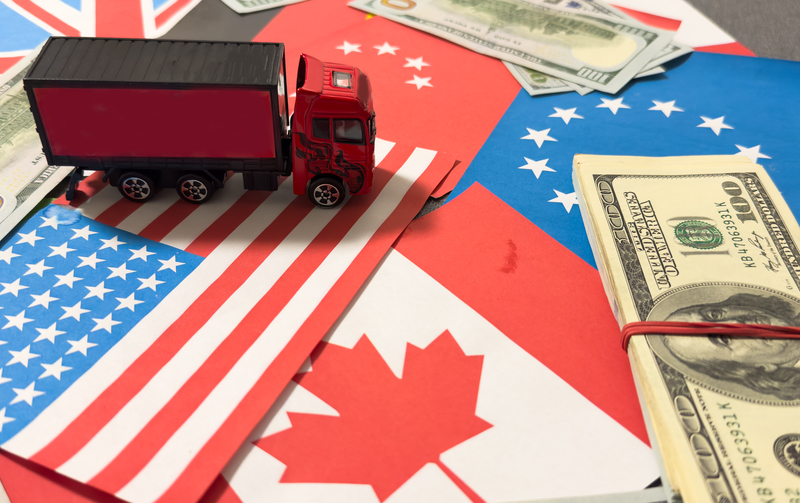 Think of import tariffs as a toll booth at the border.
Think of import tariffs as a toll booth at the border.Let me break down tariffs in the simplest way possible. Think of import tariffs as a toll booth at the border. When goods come into Canada, our government might charge a percentage of their value. We do this to protect Canadian industries like our auto manufacturers, steel producers or dairy farmers, raise some government revenue, or retaliate when other countries tariff our exports. The retaliation part often involves responses to U.S. (and other countries) trade actions.
How Tariffs Impact Your Canadian Small Business
💰 Who Really Pays Tariffs?
According to a recent Doane Grant Thornton LLP analysis, "As tariffs are in fact, duties, the importer of record is generally responsible for paying any duties/tariffs that are applied. The importer of record could be the buyer or the seller (or some other person). The cost of tariffs is generally ultimately passed on to the final user or consumer".
Source: Impact of tariffs on Canadian businesses, Doane Grant Thornton LLP, July 2025
Translation - When you import goods, YOU pay the tariff to the government upfront, then pass that cost to your customers through higher prices.
Here's the compliance piece many miss: as the importer of record (see note), you're legally responsible for paying tariffs correctly. Get it wrong, and you face penalties on top of the tariffs. This isn't like sales tax where mistakes are easily fixed – customs violations can haunt your business for years.
Note: The importer of record could be the business owner themselves if they're importing directly, or their supplier if buying from a Canadian distributor who imports.
Export tariffs work differently. When the U.S. puts a 25% tariff on Canadian products, American importers pay that to the U.S. government. But here's what actually happens: those American companies often demand price cuts from Canadian suppliers to stay competitive. So you (the Canadian business owner) eat the cost indirectly. It's like being forced to put your products on sale, permanently.
... the breadth and depth of the changes in U.S. trade policy have become more fully apparent. Specifically, under the new U.S. approach, countries must now ‘buy access to the world’s largest economy’ through tariffs, investments, unilateral trade liberalization, and policy changes in their home markets.
Prime Minister Mark Carney, August 2025
How This Hits Your Bottom Line
Understanding the practical impact of tariffs helps you prepare for potential challenges in your business operations. Let's look at three areas that can affect your business:
- Direct Import Impact - If you import any goods (services are a bit different - tariffs are generally not a direct concern), tariffs create immediate cash flow problems. For example, consider a furniture retailer importing from the U.S.. When Canada retaliated with tariffs, her costs jumped 25% overnight. But here's the compliance nightmare: she had to pay those tariffs when the goods arrived, not when they sold. That's a massive cash flow hit that many businesses aren't prepared for. It requires careful financial planning.
- Indirect Supply Chain Effects - Even if you don't import directly, you're not safe. Your suppliers' costs might spike from tariffed inputs. That 'Made in Canada' packaging might use American materials that suddenly cost 25% more due to tariffs. These hidden tariffs (often referred to as cascading) are everywhere, and tracking them for proper pricing is a compliance challenge.
- Export Documentation Requirements - For businesses selling internationally (exporters), tariffs often mean increased paperwork. A craft brewery shipping to the U.S., for example, now needs extensive paperwork proving origin of every component. Missing required forms can result in shipments being held at the border while competitors' products reach customers on schedule. These compliance requirements represent both time costs and potential lost sales opportunities. The compliance burden alone may drive some businesses out of export markets.
How Tariffs Impact Your Canadian Small Business
What Is Cascading?
 Simple infographic showing the cascading effect of tariffs
Simple infographic showing the cascading effect of tariffsCascading happens when the cost of a tariff gets passed along and multiplied at each step of the supply chain, which can lead to double taxation and higher prices for consumers. Let's dig a bit deeper into the steps to show how cascading works:
- Tariff is a Cost - When a small business in Canada imports goods from the U.S., a 25% tariff on those goods increases their cost. This tariff is essentially an added import tax that the importer must pay upfront.
For example:
Before tariffs, a Canadian importer pays for $100 worth of goods = $100 total cost
After tariffs, a Canadian importer pays for 25% tariff on $100 = $125 total cost - Cascading Effect of Tariffs - Once the importer has paid the tariff, the increased cost of the imported goods can cascade through the supply chain. If the importer is a wholesaler, they may pass this increased cost onto retailers, who then pass it on to consumers. Each party in the supply chain adds a margin to cover their costs, including the tariff, which compounds the effect.
For example:
Before tariffs, an importer sells to a Canadian retailer at $100 + 30% markup = $130
After tariffs, an importer sells to a Canadian retailer at $125 + 30% markup = $162.50 - Impact on Prices - Just like how PST/RST can cascade through supply chains in provinces that use these taxes, tariffs create the same compounding effect. The cascading effect of tariffs results in higher prices for the end consumer. Each step in the supply chain reflects the higher base cost of the goods due to the tariff, leading to compounding price increases.
For example:
Before tariffs, a Canadian retailer sells to consumer at $130 + 40% markup = $182
After tariffs, a Canadian retailer sells to consumer at $162.50 + 40% markup = $227.50
In summary, the cascading effect of tariffs leads to higher costs throughout the supply chain, impacting prices similarly to how cascading sales taxes like PST/RST do. This results from the initial tariff cost being passed along and compounded at each subsequent stage. The difference in this example is $182 before tariffs vs. $227.50 after tariffs. That's a 25% increase in consumer pricing after tariffs. Notice how the original 25% tariff became a 25% price increase to consumers due to cascading markup effects.
The Hidden Ripple Effects Nobody Talks About
Here's what can go wrong!
Here's where businesses get into real trouble: the paperwork.
- Origin Documentation - Every product needs proof of where it's made. But what if your 'Canadian' product uses 40% American materials? Suddenly you need certificates from every supplier. Miss this, and you might pay tariffs you could have avoided.
- Tariff Classification - Products have specific codes that determine tariff rates. Choose wrong? You could overpay or underpay. Underpay and face penalties plus interest. Overpay and maybe never recover the money. Getting professional help with classification isn't optional anymore.
- Record Keeping - Canada Border Services Agency can audit you years later. Every invoice, every origin certificate, every customs form needs to be perfectly organized. This isn't like keeping receipts for taxes – customs audits are detailed and unforgiving.
- Timing Issues - Tariffs change fast. That shipment you ordered in June might face different rates when it arrives in August. Your purchase orders need clauses addressing who pays if tariffs change mid-shipment.
An example: Aluminum tariffs and beverage cans
Let me paint you a picture of how integrated our supply chains really are. Canada doesn't manufacture 473 ML beverage cans. (FYI They do manufacture 355 ML cans.) That's right! That beer you are holding is in a can manufactured in the U.S. Crazy right? Well it gets crazier. The aluminum in the cans is from Canada. So let's see what happens now that tariffs apply.
Canadian aluminum gets tariffed entering the U.S. at 25%. The U.S. can manufacturer's costs go up as they are now paying more. As a result, the U.S. can manufacturer raise prices on finished cans to cover the tariff cost. Canadian beverage companies (including beer crafters) importing the cans pay more for those cans. It especially hurt when Canada imposed retaliatory tariffs ... this means there is a hit to aluminum cans on both exports and imports. Double whammy! Canadian beverage companies pass along the additional costs so Canadian consumers pay more for drinks. So far, the 8 to 10 cents a can tariff costs are being absorbed by craft breweries. But they will not be able to sustain this cost. At some point they will have to pay along the costs. Removal of the retaliatory tariffs will help but not entirely.
This is happening across hundreds of products. That 'Made in USA' product might be 40% Canadian materials. When those materials get tariffed, you pay more for the 'American' product. It's economic whack-a-mole.
Long-term, the U.S. manufacturer will likely try to find non-tariffed aluminum sources, which could hurt Canadian aluminum exporters even more. This is one reason why tariffs are so disruptive to integrated supply chains. Even if you're not directly exporting the tariffed product, if that product is an input in something you later import, you still get hit.
But businesses adapt. One solution gaining traction is for Canadian aluminum manufacturers to build (or retool) large size beverage can manufacturing plants right here in Canada. Instead of shipping raw aluminum to the U.S. for processing into large cans, then importing those finished cans back to Canada, the entire process stays domestic. No tariffs, shorter supply chains, and Canadian beverage and beer companies get more predictable pricing.
This kind of supply chain reshoring is happening across industries. Tariffs don't just change prices. They can reshape where and how things get made. For example, it has been suggested that Canada go back to using those stubby beer bottles. This is another example of how trade tensions can reshape where and how things get made.
This reshoring trend is getting policy support too. The federal government is currently working with provinces and territories to reduce internal trade barriers within Canada, making it easier for businesses to source domestically and avoid international tariffs altogether.
This is a great example of how both private business adaptation AND policy changes are responding to the same tariff pressures.
How Tariffs Impact Your Canadian Small Business
💡 Learning Moment: Four Ways to Handle Tariff Costs (And Why Smart Businesses Mix Them)
When tariffs hit your business, you've got four basic options.
Harvard's Alberto Cavallo has been studying a puzzle: why aren't the Trump administration's 2025 tariffs showing obvious immediate effects on the U.S. economy? As he notes, "There are essentially three parties who can end up bearing the cost of tariffs. ... It could be foreign exporters, it could be the US firms that are bringing those goods into the US, or it could be US consumers." (Bloomberg Businessweek, August 7, 2025) His research reveals the hidden timeline of tariff impacts. Bloomberg's analysis added a fourth scenario - products simply vanishing from markets when tariffs make them unprofitable. Honestly, these strategies can teach us a lot about business decision-making.
Here are your four strategic options to handling tariff costs during trade tensions between countries:
- Ask suppliers to share tariff costs. Some will say yes, especially if they worked hard to win your business. Why? They know that if you switch suppliers during the chaos, you might never come back even after tariffs end. Relationships are investments they don't want to lose.
- Absorb costs yourself temporarily. This is what many U.S. companies are doing right now. They're betting tariffs might disappear, so why anger customers with price hikes that could be temporary? General Motors just reported $1.1 billion less profit doing exactly this. It's expensive, but keeps customers loyal.
- Raise prices gradually. Nobody wants to shock customers with sudden 25% increases. Smart companies use 'price creep' (small increases over time that feel less offensive). A 5% increase every few months hurts less than one big jump.
🦆Duck Wisdom: Only pass along actual tariff costs, not inflated 'tariff-related' increases. Customers aren't stupid. They'll figure out if you're using trade tensions as an excuse to boost margins. That destroys trust and hands your competitors an advantage when tariffs eventually end. - Find alternative suppliers. Sometimes you quietly source from domestic suppliers (no tariffs) or countries with lower tariff rates. Meanwhile, you might discontinue products that become unprofitable rather than raise prices too high.
For example, I've been reading lately how some restaurants are restructuring their menus to remove dishes that are too expensive for customers and creating another entree option that is affordable.
The Real Strategy
Most successful companies don't pick just one approach - they combine them. They might negotiate with current suppliers to temporarily share some costs (#1), absorb what's left temporarily (#2), gradually raise prices in small increments (#3), while quietly developing alternative suppliers (#4). It's survival tactics, not textbook theory.
Don't Forget Government Support
While you're mixing these strategies, remember that temporary government relief programs (like tariff remission processes) can help bridge the gap. But don't count on them as your primary strategy. They're designed as short-term assistance while you implement longer-term solutions. Think of government support as buying you time to execute your real strategy, not as the strategy itself.
For example, the temporary remission from Canadian import tariffs on steel used for manufacturing, packaging food and beverages, and farming ends January 31, 2026. This relief began on March 13, 2025 when Canada announced retaliatory tariffs on steel and aluminium.
The Timeline Reality
Companies typically try this combination for 6-18 months before moving more heavily toward price increases. Understanding this helps you predict when your U.S. customers might start feeling the real pinch.
Source: It's Only a Matter of Time Until Americans Pay for Trump's Tariffs, Bloomberg Businessweek, August 7, 2025
Then there's the currency chaos. Tariffs mess with the Canadian dollar (CAD). When trade tensions rise, the CAD often weakens, making your imports even more expensive. It's a double whammy with tariffs. Your exports might get a bit more competitive with a weaker dollar, but that's small consolation when your costs are skyrocketing.
But here's what's really killing businesses: uncertainty. When you don't know if tariffs are coming, going, or changing, how do you plan? Do you sign that long-term supply contract? Do you invest in that new equipment? Do you hire those extra workers? Many businesses are sitting on their hands, which slows the whole economy down.
Your Early Warning System
Here's how to see it coming!
 You can't afford surprises. Compliance is your competitive advantage.
You can't afford surprises. Compliance is your competitive advantage.You can't afford surprises. Here's your compliance-focused monitoring system:
Set up Google alerts for "Canada retaliatory tariffs', 'CUSMA' plus your industry, and your specific products plus 'tariff'. But also monitor 'customs compliance' and 'CBSA audits' – enforcement often increases during trade disputes.
How Tariffs Impact Your Canadian Small Business
⚡ How Fast Tariffs Hit: Zero to 25% in One Day
According to a recent Doane Grant Thornton LLP analysis, "On March 4, 2025, the federal government announced it will move forward with a 25% tariff on $155 billion in goods imported from the United States" with immediate effect on "$30 billion" worth of goods including "orange juice, peanut butter, wine, spirits, beer, coffee, appliances, apparel, footwear, motorcycles, cosmetics, and certain pulp and paper products".
Source: Impact of tariffs on Canadian businesses, Doane Grant Thornton LLP, July 2025
Wake-up call - That's same-day implementation. No grace period. No warning. This is why you need an early warning system NOW. Note these retaliatory tariffs are being removed on September 1, 2025.
Understanding Different Communication Styles
You can't afford to be surprised by tariff changes. It's important to pay attention to tariff negotiations in both countries. If you have been following along already, you may have noticed that tariff monitoring is tricky because currently, different governments are communicating differently about trade policy. Understanding these different styles is important for your planning.
U.S. announcements currently (2025) often come through social media or public statements, sometimes as negotiating positions rather than final policy. These can move markets quickly, but not every announcement becomes actual policy.
Under the current government (2025), Canadian responses are typically following a more measured, consultation-heavy approach: diplomatic channels first, industry consultations, then official government announcements when decisions are final. This consultation process can involve input from the federal cabinet, premiers, businesses, indigenous leaders, and the Prime Minister's trade advisory council - ensuring all affected sectors have input before policy decisions are made. When Canada does announce retaliatory tariffs, they're usually carefully targeted and actually happening.
Let’s be absolutely clear: Canada currently has the best trade deal with the United States, and while it’s different from what we had before, it is still better than that of any other country.
Prime Minister Mark Carney, August 2025
What Does This Mean for Your Planning?
- Monitor U.S. announcements for early warning signals.
- Wait for official Canadian government notices before making major business changes.
- Expect consultation opportunities - if your industry might be affected, you may have chances to provide input through your industry association or direct government consultation.
- Expect Canadian responses to follow a predictable timeline: initial diplomatic response → comprehensive industry consultation → official policy announcement → support programs for affected sectors. This predictable pattern helps you plan instead of panic.
Here's A Suggested Monitoring Checklist For You:
- Join industry associations – they often participate in government consultations and share advance warning. They often know what's coming before it's announced. The Canadian Federation of Independent Business (CFIB) supports and advocates for small businesses in Canada.
- Watch for consultation announcements from government - this is your chance to have input. It is expected that the federal government will be holding industry consultations beginning this September. The objective would be to set priorities for the upcoming CUSMA review in 2026.
- Pay close attention to your supplier price increase notices. They might mention 'market conditions' or 'currency fluctuations', but often they're really talking about tariff impacts. Dig deeper as they might be passing on tariff costs without proper documentation, leaving you exposed.
- Set up alerts for both countries' trade announcements.
- Follow your industry association's communications closely.
How Tariffs Impact Your Canadian Small Business
Why Political Context Matters for Business Planning
Understanding different government communication styles isn't about politics. It's essential business intelligence*. Here's why:
- Timing Predictability - Canada's consultation-heavy approach means responses may take longer to develop, but once announced, they're more likely to remain stable policy. This gives you more certainty for long-term business planning compared to policies that might change quickly.
- Planning Advantage - Knowing that Canadian tariff decisions typically involve stakeholder consultations means there may be opportunities for you to participate in the process through your industry association, rather than just reacting after decisions are made.
- Risk Management - Understanding that U.S. announcements might be negotiating positions while Canadian announcements are usually implemented policy, subject to updates, helps you calibrate your response appropriately. Canadian policies are serious and actionable when announced, but the government maintains flexibility to adjust as the unpredictable trade environment evolves.
- Bottom Line - The current global trading environment requires you to monitor political developments not as a partisan exercise, but as a core part of protecting your business operations and cash flow.
*What is Business Intelligence?
Information gathering and analysis that helps you make better business decisions. Think of it like weather forecasting for business. In this case, it means monitoring political/trade developments the same way you'd monitor economic indicators, industry trends, or regulatory changes - as factual data that affects your operations, not as partisan politics.
In short, small business owners like you need to pay attention to political developments not because you want to, but because your business survival depends on it protecting your business from surprises.
Practical Strategies That Actually Work
Here's what to do about it!
Quick Reference
- Build tariff reserves into pricing
- Consider factoring for cash flow
- Renegotiate contracts with tariff clauses
- Document alternate suppliers now
- Keep debt low, build cash reserves
Let's get down to brass tacks. What can you actually do about all this?
For short-term survival, you need to get aggressive about three things. First, price strategically. Build tariff contingencies into your quotes. Use shorter-term pricing so you're not locked in when costs spike. And be transparent with customers about why prices change – they'll appreciate the honesty.
Second, manage your cash flow like your business depends on it, because it does. Remember, tariffs are due when goods arrive, not when you sell them. This can create a serious cash crunch. Consider factoring, which means selling your outstanding invoices for immediate cash. For example, if you have a $10,000 invoice that won't be paid for 60 days, a factoring company might give you $9,500 today. Yes, you lose 5%, but it keeps cash flowing when you need it for tariff payments.
You might also need to expand your line of credit or time purchases more strategically. Buy before tariffs hit if you can, but don't overdo it – carrying excess inventory has its own costs.
Third, renegotiate everything. This is no time to be shy. Talk to suppliers about sharing the tariff pain. Lock in prices where you can. Consider cost-plus arrangements, where instead of agreeing to a fixed price, you pay your supplier's actual cost plus a predetermined markup. For instance, instead of buying at $100 per unit fixed, you might agree to pay their cost plus 15%. When tariffs hit and their costs jump to $120, you pay $138. When tariffs drop and costs fall to $80, you pay $92. This shares the risk fairly and avoids constant renegotiation.
For long-term resilience, you need to think bigger. Diversify your supply chain so you're never dependent on one country. Consider reshoring some supplies to avoid border issues altogether. Build relationships with multiple suppliers so you have options when things go sideways.
Develop new markets too. If U.S. sales drop, where else can you sell? Other provinces? Online markets? Don't wait until you lose your biggest market to start looking for alternatives.
And get financially nimble. Keep debt low, build cash reserves, and have contingency plans. The businesses that survive disruptions are the ones with financial flexibility.
How Tariffs Impact Your Canadian Small Business
💡 Government Relief Available
There's some good news for businesses struggling with tariff impacts. The federal government has introduced a remission process that "will allow Canadian businesses to request relief from the payment of tariffs or a refund of tariffs already paid" particularly for "situations where goods used as inputs can't be sourced domestically (on a national or regional basis) or reasonably from non-US sources." PM Carney announced November 26, 2025 that this temporary remission ends January 31, 2026.
Source: Impact of tariffs on Canadian businesses, Doane Grant Thornton LLP, July 8, 2025
What this means for you - If you're importing specialized equipment or materials that simply aren't available in Canada, you may be able to get your tariff payments back. Document everything – you'll need to prove negative availability. It's worth investigating if your imports qualify.
Understanding Government Support: A New Business Environment
The support landscape has shifted dramatically as it responds to the current trade tensions. The current federal leadership brings financial sector experience – the Prime Minister understands that cash flow problems kill businesses faster than profitability issues ever will.
This shows in program design. Tax deferrals? They know you need cash now, not next year. Remission programs? They recognize some imports simply have no Canadian alternative. EI modifications letting you reduce hours instead of laying off staff? That's understanding the real cost of losing trained workers you spent months (or years) training.
But here's the catch: these programs assume business sophistication. They're designed by people who understand complex business, for businesses that can navigate complex applications. The tariff remission process isn't a simple online form – it requires proving that alternatives don't exist, understanding tariff classifications, and maintaining detailed documentation that would make an accountant proud!
The consultation process has changed too. Instead of two-year studies, we're seeing faster decision making: quick stakeholder input through advisory councils, rapid program design to respond to the changing volleys in the trade tensions, faster short term implementation measures (there is still some lag time implementing longer term solutions). Great if you're ready, challenging if you're still figuring out what hit you.
Here's a reality check. The August 22nd expansion of U.S. tariffs to 407 steel derivative products (everything from wind turbines to baby strollers) shows how quickly this environment changes. As Canadian Steel Producers' Association CEO Catherine Cobden put it, "This list was much broader than we expected it to be." If industry associations are getting surprised, imagine where that leaves individual small businesses.
Government Relief: Programs Evolve Based on Industry Feedback
The good news? Federal and provincial / territorial governments are responding, and programs are evolving based on what's actually happening in the real world; governments refine their support packages based on tariffs enacted.
For example, when 25% steel tariffs imposed in March jumped to 50% in June and then expanded to derivative products in August, Canada's response evolved through industry consultation to introduce sectoral relief. In July 2025, Prime Minister Carney announced enhanced steel industry relief including "$70 million in new funding over three years to help steel workers get retrained" and measures to "prioritize the purchase of Canadian steel in procurement for infrastructure projects" (Toronto Star, July 16, 2025). But as the August expansion shows, this is an ongoing chess game, not a one-time fix.
Beyond the remission process for tariff relief, governments at all levels are rolling out support programs as trade tensions persist. The key is knowing where to look and acting quickly when programs open.
The Large Enterprise Tariff Loan Facility (LETL) "aims to provide financial support to eligible large businesses—particularly those vital to Canada's food, energy, economic, and national security—that are struggling to secure traditional financing due to the US trade conflict" (Impact of tariffs on Canadian businesses, Doane Grant Thornton LLP, July 8, 2025). While you might not qualify directly, these programs create ripple effects. If your major customer gets support, they're more likely to keep buying from you instead of switching suppliers or cutting orders.
Provincial programs are all over the map but often include:
- tax deferrals
- low-interest loans
- grants for supply chain adaptation.
Recent analysis shows businesses tracked responses including Ontario's "$11 billion in relief including 6-month tax deferrals" and Quebec's "loans up to $50 million for business model adjustments" (Impact of tariffs on Canadian businesses, Doane Grant Thornton LLP, July 8, 2025).
The challenge? These programs often have short application windows and specific eligibility criteria that change as situations evolve.
Don't assume you're too small to matter. Many programs start for large businesses then get adapted for SMEs. Others flow through industry associations or regional development agencies specifically targeting smaller operations. The key is staying informed and being ready to move quickly when programs match your needs.
The documentation reality. As international trade lawyer John Boscariol noted about the derivative products expansion, "They have to go back and figure out exactly where each component came from. There are all kinds of costs you're introducing on top of the tariffs" (Toronto Star, August 22, 2025). This complexity applies to government support applications too – you need to prove your case with documentation.
What does this mean for you and your business? Government support is available and evolving, but it requires preparation and sophistication to access. The businesses that benefit are those that treat government relations like any other business function ... with dedicated attention, proper documentation, and strategic thinking.
Remember, initial government responses often get enhanced after industry feedback. If current programs don't meet your needs, engage through your industry association. Set alerts for '[your industry] tariff relief Canada' and watch for program updates, not just initial announcements.
Sources: Impact of tariffs on Canadian businesses, Doane Grant Thornton LLP, July 8, 2025; 'Steel is the very foundation of Canada.' Carney delivers aid package to industry, workers ravaged by Trump tariffs, Toronto Star, July 16, 2025; Josh Rubin, Canadian steel and aluminum industries already reeling from Donald Trump's 50 per cent tariffs have received another blow, Toronto Star, August 22, 2025
How Tariffs Impact Your Canadian Small Business
VAT vs. Tariffs: Why the Economics Matter to You
Let's dig deeper to understand why it works this way!
Remember we chatted about business intelligence earlier? Well now I want to dig a bit deeper to help you understand why governments use tariffs as a tool despite its economic inefficiencies ... instead of something like our GST, which is a type of VAT. It's not about economics. It's about politics.
From an economic standpoint, VAT is actually much better. It's predictable because it's the same rate on everything. It's neutral because it doesn't favor imports or domestic products. Most importantly for you as a business owner, it's neutral to your business because of Input Tax Credits. You reclaim what you pay, so only end consumers bear the cost. And it raises more money with less economic damage to boot.
Think about it this way. With GST, if you buy $1,000 of supplies and pay $50 GST, then sell $2,000 of products and collect $100 GST, you simply remit $50 to the government. Your business isn't out any money. With a tariff, if you pay $50 on imports, that's a real cost you need to recover through higher prices.
So why do tariffs persist? As mentioned earlier, historically, tariffs have served different policy purposes beyond revenue generation:
- Industry protection - They can shield domestic industries from foreign competition. (Think of the most recent steel tariff-rate quota (TRQ) announced by the government in July.)
- Negotiating tools - They're used as leverage in trade disputes and trade agreement revisions. (Think CUSMA.)
- Political messaging - They can appear to target foreign countries rather than domestic consumers.
The new reality? Recent U.S. policy analysis suggests tariffs are increasingly being used as a revenue generation tool to offset other tax reductions in American fiscal policy. (Think the One Big Beautiful Bill Act passed in July 2025.)
This makes economic sense from a government budget perspective. Tariffs can raise substantial revenue quickly without requiring new domestic tax legislation. However, this approach shifts the tax burden from income earners to consumers of imported goods, creating different economic impacts than traditional tax policy.
As a business owner, you need to deal with reality as it is, not as it was or as you wish it were. Prime Minister Carney made this clear in his August 22, 2025 announcement when he said that "nobody has a deal with the United States that they used to have" and that the U.S. has "fundamentally changed their trade policy."
This isn't a temporary disruption you can wait out. It's the new normal for international trade. The businesses that will thrive are those that adapt their operations to this reality rather than hoping for a return to previous trade relationships.
The economic reality? When the U.S. uses tariffs primarily for revenue generation rather than trade protection, they function essentially as a consumption tax paid by domestic businesses and consumers. This revenue can offset other tax reductions, but tariffs are less efficient than VAT systems at raising revenue while creating more economic disruption.
🦆Quack Fact: The U.S. is one of the few developed countries that does not have a VAT tax. This makes tariffs more attractive as a revenue tool in the U.S. than in countries with established VAT systems.
Bottom line for your business ... understanding this difference helps you plan better. GST/HST costs are recoverable and predictable. Tariff costs are real expenses that directly affect your pricing strategy and cash flow whether you are importing or exporting.
Your Action Plan For This Week
 Start by starting. Here is your action plan for tariffs.
Start by starting. Here is your action plan for tariffs.Don't wait. This week, take these specific steps:
- Audit Your Compliance Exposure - List every product you import or export. Document their tariff classifications. Use Canada's official Tariff Finder tool (https://www.tariffinder.ca/en/) to quickly get current tariff rates for your specific products - it's intuitive and works even without HS codes. Identify which suppliers provide origin certificates. Calculate your exposure at different tariff levels (10%, 25%, 50%). This isn't optional anymore. You can't manage what you don't measure.
- Strengthen Your Documentation - Create a customs compliance binder. Include supplier certificates, classification rulings, and CBSA correspondence. When auditors come, first impressions matter.
- Review Your Contracts - Every supplier agreement needs a tariff clause. Who pays for changes? How quickly must they notify you? What documentation must they provide? Get legal help if needed. Contract gaps cost more than lawyer fees.
- Build Your Knowledge Base - Register for CBSA's online portal. Subscribe to their tariff notices. Join the Canadian Society of Customs Brokers forum. Knowledge prevents expensive mistakes.
- Secure Your Financing - Approach your bank now about increasing your line of credit. Show them your tariff exposure analysis. Banks prefer lending to prepared businesses, not desperate ones. Meanwhile, accelerate collections – even offering small discounts for fast payment beats waiting 60 days when you need cash for tariff payments. Defer non-essential spending. Cash is king during uncertain times.
- Strengthen Your Key Relationships and Plan Scenarios - Talk to suppliers about their tariff exposure – their problems will become your problems. Discuss contingency plans with major customers. Share information with industry peers. You're all in this together. Then create scenario plans: What if tariffs hit your imports? What if they hit your exports? What if your customers get squeezed? Hope for the best but plan for the worst.
The Bottom Line: Build Systems, Don't Wing It
Understanding how tariffs impact Canadian small business isn't just about economics; it's about survival and preparation.
Here's the truth. You can't control whether tariffs get imposed or retaliated. You can't control currency fluctuations or global trade tensions. But you can control how diversified your business is, how much cash buffer you maintain, how quickly you adapt to changes, and how well you communicate with stakeholders.
Every business faces the same tariff challenges, but not every business will handle compliance properly. Those that do will avoid penalties, access relief programs, and maintain customer trust. Those that don't will face audits, penalties, and cash flow crises.
Don't try to 'wing it' with customs compliance. In today's environment, that's business suicide. Tariffs aren't temporary inconveniences. They're the new reality requiring permanent flexible systems.
The good news? Proper compliance isn't rocket science. It's about documentation, classification, and staying informed. Get these right, and tariffs become manageable costs, not existential threats.
The businesses that will thrive won't be those unaffected by tariffs. They'll be those with bulletproof compliance systems who see change coming and adapt fastest. While competitors scramble with customs problems, you'll be focusing on growth.
Repeat after me ... compliance is my competitive advantage!
Final Thoughts: This Too Shall Pass (But Prepare Anyway)
I've lived through decades of softwood lumber disputes, NAFTA negotiations, and more trade wars than I care to remember. Trade disputes are like storms. They're disruptive, sometimes damaging, but they do pass.
The businesses that survive and thrive are those that stay informed without obsessing, prepare without panicking, and adapt without abandoning their core business. Remember, every challenge creates opportunities. While your competitors are paralyzed by uncertainty, you can be positioning for growth. Some of the best businesses were built or transformed during turbulent times.
For your small business, the new economic reality is the level playing field in trade is changing. When Prime Minister Carney discussed "unilateral trade liberalization" in August 2025, he was describing (in fancy language) the price Canada must pay to maintain privileged U.S. trade access. Under the new American approach, countries must 'buy access to the world's largest economy,' meaning Canada voluntarily removes trade barriers without reciprocal concessions from the U.S..
Translation ... This means facing increased foreign competition at home as the cost of preserving what Carney calls "the best trade deal with the United States" (i.e. maintaining access to the U.S. export market). This likely isn't a temporary adjustment - it's exactly why you need permanent flexible systems, not quick fixes. The businesses that thrive will be those prepared for both increased domestic competition and continued U.S. market opportunities.
While you'll encounter more competitive pressure domestically, you're maintaining access to American customers that other countries are paying much higher prices to reach. Plan accordingly by leveraging this continued U.S. market access while strengthening your position against new foreign competitors entering Canada.
What's your biggest tariff concern right now? Understanding your specific vulnerabilities is the first step to building systems that protect your business. Because in these uncertain times, the one certainty is that customs compliance has moved from 'nice to have' to 'must have'.
Stay nimble, stay informed, and remember – you've navigated challenges before. This is just the next one.
I've walked you through what you can't control and what you can, shown you how compliance becomes your competitive advantage, and given you practical steps to weather these trade tensions. Good Luck!
Back to top